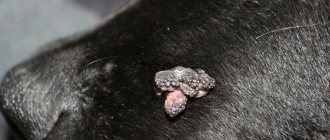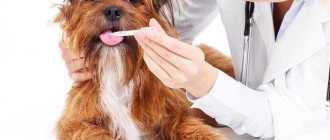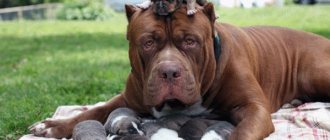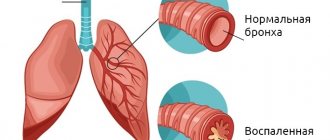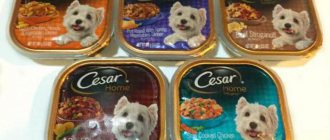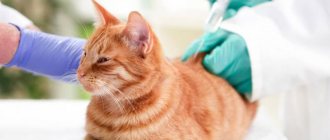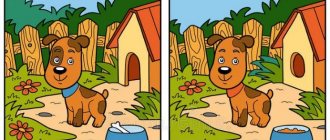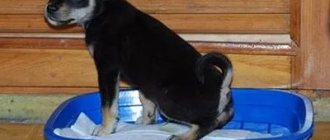Full health of a dog means the good condition of all its organs and systems, including teeth. Unfortunately, these friendly animals, which have served man faithfully for a long time, have not been spared many “human” diseases. One of them is an incorrect bite in a dog.
For breeding puppies or service breed dogs, this disease becomes a death sentence, excluding the right to serve or breed. In addition, this deficiency greatly affects the dog’s overall health.
Consequences of malocclusion for a dog's health
The chewing apparatus is the beginning of the gastrointestinal tract. Therefore, disturbances in its structure inevitably affect the functioning of the digestive system:
- difficulty in eating and chewing food causes gastrointestinal disorders;
- severe malocclusion can cause oral injuries;
- loose jaw closure leads to constant drooling, which means the appearance of weeping eczema and dermatitis.
At the same time, if minor deviations from the norm do not worsen the quality of life of the animals, then correcting the bite in dogs may not be necessary.
In any case, the final decision on further actions must be made by a veterinarian orthodontist.
Dentures for dogs
A pathological bite in a dog, as already mentioned, easily leads to various types of dental problems in the pet. It is often impossible to correct this defect. In this case, dogs' teeth wear down very quickly. And so that the animal does not have problems with the gastrointestinal tract, in this case it is possible to order prostheses for it.
The technology for performing a dental procedure is similar to the technique for installing crowns in humans. Such a procedure is, of course, expensive. But it also helps to maintain your pet’s health very effectively. Unlike people, dogs often have metal teeth inserted into them. After all, such crowns are cheaper than ceramic ones.
Currently, not all veterinary clinics provide dental installation services for dogs. But finding a specialist who has the skills to install crowns on animals in our time will not be difficult, including in Russia.
Types of bite
Let's consider what types of bites exist (from normal to pathological) and what evil can be expected from the incorrect arrangement of teeth.
The main functions of dog teeth are:
- Capturing prey. It is carried out by fangs and incisors. Four fangs (2 on each jaw) have an elongated, slightly curved shape. Between them there are smaller incisors.
- Chewing food. This task is performed by molars (premolars and molars). They are located at the back, behind the fangs.
Normal bite
Normal bite (orthognathia) is also called scissor bite. When the mouth is closed, the lower incisors should press closely against the back of the upper incisors. A scissor bite ensures normal chewing of food, protects the soft tissues of the oral cavity from traumatic disorders, and ensures normal retention of prey.
Purebred dogs that have deviations from this form of jaw closure are always mercilessly disqualified and not allowed for breeding. The reason for this strictness is that bite defects often begin to form as a result of genetic disorders. This pathology can be inherited.
Pathological bite
There are several options for pathological bite:
- A straight (pincer) bite is sometimes considered a normal variant. The incisors of the lower and upper jaws touch with their cutting edges. In this position, these teeth are subject to a large load for which they are not designed. The disadvantage of this bite is the rapid grinding of the incisors. The remaining teeth are not affected.
- Undershot (prognathia). A shortened lower jaw causes the incisors to not touch each other. Canines, premolars and molars take on the entire load, which leads to their rapid wear. Undershot is considered a disqualifying characteristic for all dog breeds without exception.
- Snack (progenia). The peculiarity of the structure of the muzzle is such that the lower jaw protrudes far forward, opening the incisors. Bulldogs and boxers have this skull structure. Therefore, for dogs of these breeds, snacking is not a defect.
- Asymmetrical bite. Formed when one side of the jaw is more developed than the other. May be a common cause of health problems. This is a disqualifying sign that applies to all breeds of dogs.
- Open bite. It is formed due to improper growth of the incisors, which do not close at all when the jaws are closed.
Modern methods of orthodontic bite correction in dogs using braces
Bite
- this is a feature of the relationship between the chewing surfaces of the teeth of the upper and lower jaws when they are closed. A normal bite is the correct relationship between the jaws and the teeth located on them. And, accordingly, malocclusion is a discrepancy in the relationship between the upper and lower jaws, as well as the incorrect arrangement of individual teeth (dystopia) or a whole row of teeth in the dental arcade on correctly developed jaws.
The normal type of bite is a scissor bite.
- this means that the upper incisors overlap the lower ones and come into contact with them.
Also, a normal bite in some dog breeds includes progeny (overbite) - protrusion of the lower jaw beyond the upper jaw. This condition is considered normal in boxers, bullmastiffs, Pekingese, Shih Tzu, bulldogs, pugs, and is considered an anomaly in other dog breeds. In this case, in some cases, injury to the gums of the lower jaw by the teeth of the upper jaw does not occur.
Pincer (straight) bite
- this is the contact of the chewing surface of the incisors of the upper and lower jaws during closure. For some breeds this is the norm (American Pit Bull Terrier, sometimes allowed in small breeds of dogs).
Prognathia (undershot)
is a condition in which the upper jaw is longer than the lower jaw, causing the upper incisors to overlap the lower incisors without touching. Prognathia is not considered normal for any breed of dog. The only exception is puppies, since over time this type of bite can change to normal.
Causes of malocclusions
The most common cause of malocclusion, unfortunately, cannot be eliminated. This is a hereditary factor. The only way to prevent its spread to offspring is to deprive genetically inferior animals of permission to breed.
In addition, this pathology can also be acquired. It is most often caused by insufficient care of the puppy. There are several such factors:
- Repeated heavy loads on the teeth of a young animal during active games of tug are very unhelpful for him. You need to carefully control the force with which the puppy pulls the coveted toy.
- The consequences of trauma and damage to the jaws when chewing bones and hard objects often lead to malocclusion.
- Violation of the timing of the loss of milk teeth leads to the fact that the growing molars, bumping into the missing milk teeth, change their direction of growth.
- Lack of calcium, vitamin D, and an unbalanced diet lead to rickets and gradually deform the bite.
- Abnormally short labial frenulums cause the teeth to be compressed, causing the bite to become pathological.
How to solve a problem
Acquired malocclusions can be corrected. This is not a task for one week or even a year, but the efforts will be generously rewarded. Upon completion of treatment, the dog will be able to take part in exhibitions and will be allowed to breed.
But even if the owner does not have the goal of pursuing a show career, it is necessary to treat his pet’s pathological bite. This is the key to his health and full life. It is better to do this when the puppy is not yet a year old.
Let's look at how to correct a dog's bite. This can be done in several ways, namely:
- removable devices;
- non-removable structures.
Removable devices
These include the so-called transparent removable aligners. They are placed over the teeth and should be worn at all times except when eating and brushing teeth. Their effect is constant and fairly strong pressure on the teeth in the desired direction. Every few months the design is replaced with a new one. It exerts stronger pressure, under the influence of which the teeth take the right direction. The orthodontic veterinarian must monitor the treatment process.
Removable braces can be used for puppies. They are shaped like a hard rubber ring. The principle of their action is the same, but they exert gentler pressure on the teeth.
Fixed structures
These are permanent braces. They are made of dense material and are firmly attached to the teeth using special dental glue. The force of their pressure is regulated using a special wire that connects the clasps that are put on the teeth. If necessary, the wire can be changed, thereby increasing or decreasing the pressure force.
Fixed structures have their contraindications. They cannot be installed if you have periodontal disease, stomatitis, or an allergic reaction to the braces material. Treatment is usually long-term.
Prevention of malocclusion
There are simple rules of prevention that a caring owner must follow. If you start monitoring the condition of your teeth while the puppy is still very young, then problems in this area can be avoided.
You just need to keep in mind that these rules will only have an effect if malocclusions have not been inherited by the dog from its parents.
- One of the most important conditions is a properly formulated puppy diet. Dry food intended for this age category is well suited. They contain all the nutrients, vitamins and minerals necessary for dogs of a certain age.
- Natural food must be artificially enriched with microelements. But here it is also important not to overdo it. It is best if the dog’s diet is prepared by his treating veterinarian.
- It is necessary to monitor the development of the baby’s chewing apparatus. It is worth carrying out regular external examination of the oral cavity.
- Particular attention should be paid to the process of replacing milk teeth with permanent ones. If baby teeth do not fall out for a long time, you should speed up the process by removing them at home or in a veterinary clinic.
- What should you do if your puppy chews on everything and suffers from severe itching of the gums during teething? In this case, you should offer him special teething toys. They are made of soft, elastic materials that do not harm their teeth.
If a dog lives with an incorrect bite for a long time, the owner has virtually no chance to correct the situation. Therefore, it is important to notice the problem in time, and if it significantly worsens the animal’s quality of life, take all necessary measures.
Periodic inspections
To prevent the development of malocclusion in a pet, owners should also periodically check its oral cavity. In particular, this procedure often needs to be performed during the change of the puppy’s milk teeth. If the owner discovers that they are interfering with the growth of permanent ones, the pet should be immediately taken to the veterinarian. The specialist will remove the puppy’s baby tooth, and the permanent one will grow in the correct position.
For older puppies, the oral cavity is examined to identify abnormally growing teeth. Correcting a bite in young dogs is much easier than in adults. In order to achieve the correct position of the teeth, puppies usually simply wear a special rubber ring.
